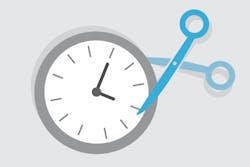When Jared Liles arrived at the Mirak Automotive Group’s collision center, just over a year ago, things were rather chaotic.
“It was like every man for himself,” Liles recalls.
Not only was the team atmosphere toxic in the body shop manager’s new workplace in Arlington, Mass., but cycle time was operating at a glacial pace, at 14 days. Employees often wandered around the shop floor looking for the proper parts at the Boston-area facility, which didn’t even have a management system.
Liles was determined to turn things around. But he would need to get his entire staff on the same page—not to mention the dealership’s parts department employees. Order would not be established quickly in Arlington.
The Problem
When Liles first arrived at Mirak, he was hesitant to implement many new processes.
“I didn’t want to rock the boat too much,” he explains.
But, before long, the facility’s multiple issues began to irritate the new manager.
“Our biggest problem was we were just taking too long to get repairs done,” Liles says.
He eventually pinpointed the eye of the storm with regard to the cycle time issues: the parts department, where one counterman was consistently holding the body shop back, causing parts to be ordered and delivered inefficiently.
“The problem that we were running into,” Liles explains, “is that the person responsible for the body shop parts, his pay was ultimately paid on just the profit of those parts. So, if it cost money to overnight a part, he wouldn’t do it, because it would take away from his bonus.
“He was very lackadaisical on getting the parts, even though I had written an entire parts ordering and receiving procedure.”
The Solution
For weeks, Liles implored both Mirak’s parts manager and the facility’s owner to re-assign the uncooperative counterman—the counterman who refused to deliver parts to technicians, saying that wasn’t his job. That irritable co-worker was costing Mirak significant money, due to inefficiencies, Liles argued.
“I said, ‘enough is enough,’” he says. “And then they finally got rid of him. Because he wasn’t going to do anything that we wanted him to do.”
Mirak’s bosses decided not to fill the newly vacated position, opting to instead have the parts manager handle the body shop’s parts requests. And, with him following Liles’ parts procedure closely, revenue increased steadily for the collision repair center. In September 2017, Liles’ department did $225,000, after averaging around $135,000 per month not long before that.
Nowadays, as soon as parts arrive in Arlington, they are promptly checked, and they soon go on a parts rack for the associated vehicle, or a runner takes parts right to a vehicle promptly, so technicians rarely have to waste time. The racks are kept in a dedicated area of the body shop, so parts are no longer scattered throughout the facility.
By the fall of 2017, Mirak’s body shop was on the upswing.
“The parts manager,” Liles says, “once he understood what we were trying to do, he got it and it clicked with him.”
The Results
The changes Liles implemented at Mirak have paid dividends. Cycle time has been whittled down to 8.6 days. The body shop’s final annual revenue figure for 2017 looks like it’ll be approximately $2.5 million. Its CSI score has climbed to 92.
Mirak even got a management system last March, and that CCC ONE setup has helped Liles’ facility keep track of cycle time, ensuring that repairs rarely drag out uncomfortably long. Now, estimators order parts through the new management system, which gets those orders in technicians’ hands in short order.
In Arlington, parts are no longer a problem, and the staff is working as a cohesive unit. Chaos has subsided.
“I think parts is one of the prime factors in negatively affecting cycle times,” Liles says, looking back on his first year at Mirak. “Because, if you don’t have somebody checking the parts when they’re coming in, mirror matching them, making sure that you have all the parts to push that car through the shop, then that’s ultimately going to be a hindrance—you just killed your cycle time.”

